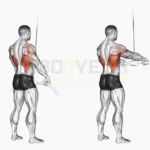Close Grip Lat Pulldown: Exercise Overview
The close grip lat pulldown is a dynamic compound exercise designed to target the latissimus dorsi, with secondary engagement of the biceps, rhomboids, and trapezius. By using a close grip, this variation emphasizes the lats while also activating the middle back, making it an effective movement for building a strong, defined upper back. Given the back’s complexity, incorporating variations in grip and angle is key to maximizing muscle development.
The close grip lat pulldown is a versatile addition to back-focused workouts, pull routines, upper-body sessions, or full-body training programs, suitable for lifters of all levels aiming for both aesthetic and functional strength (Schoenfeld, 2010).
How to Perform the Close Grip Lat Pulldown
- Attach a close grip handle (e.g., V-bar or narrow bar) to the lat pulldown machine and sit on the seat, securing your thighs under the pads.
- Grasp the handle with a double underhand (supinated) grip, hands approximately shoulder-width apart, and sit upright with your core engaged—this is your starting position.
- Depress your shoulder blades and initiate the pull by flexing your elbows and extending your shoulders, bringing the handle toward your upper chest until your elbows align with your torso.
- Pause briefly at the bottom, squeezing your lats for maximum contraction.
- Slowly return the handle to the starting position with control, allowing your shoulders to slightly shrug upward at the top.
- Repeat for the desired number of repetitions.
Tips for Optimal Performance
- Engage the Lats: Focus on pulling with your back rather than your biceps by using a false grip (thumb not wrapped around the handle) if biceps dominate the movement (Schoenfeld, 2016).
- Control the Movement: Perform the pull and return slowly to maximize time under tension and avoid momentum, ensuring effective back activation (McGill, 2010).
- Maintain Proper Posture: Keep your core braced to prevent excessive spinal arching, and avoid jutting your head forward to maintain a neutral neck position (Wirth et al., 2016).
- Allow Shoulder Blade Movement: Let your shoulder blades move naturally—slightly shrugging at the top and depressing before the pull—to optimize lat engagement and shoulder health.
- Breathe Properly: Exhale as you pull the handle downward and inhale as you return to the starting position to support core stability and muscle oxygenation.
- Choose Appropriate Weight: Select a weight that allows controlled form for your target rep range (e.g., 8–12 reps for hypertrophy) to avoid compensatory movements.
Building lats with close-grip pulldowns? Dive into our Ultimate Guide to Muscle Groups for back development.







